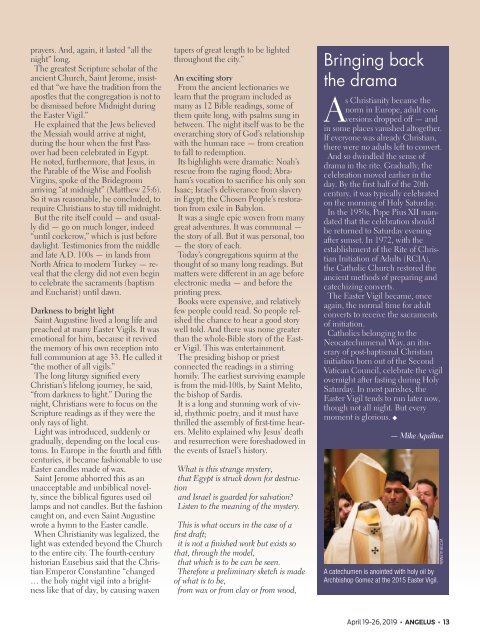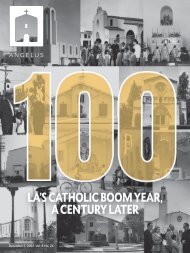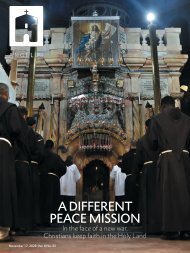Angelus News | April 19-26, 2019 | Vol. 4 No. 15
People hold candles during the Easter Vigil service at Westminster Cathedral on April 4, 2015, in London, England. Also known as the Paschal Vigil, the nocturnal liturgy celebrating the victory of Jesus Christ over death was for early Christians a night full of anticipation and dramatic symbols, rites, and singing. On page 10, contributing editor Mike Aquilina takes us back to the experience of the primitive Church to understand why the vigil was “the night of nights” for those Christians — and why it should still be for us, too. On page 16, Caitlin Yoshiko Kandil speaks to local catechumens about their road to conversion and why they’re looking forward to the “new life” of the baptism they’ll receive at this year’s Easter Vigil.
People hold candles during the Easter Vigil service at Westminster Cathedral on April 4, 2015, in London, England. Also known as the Paschal Vigil, the nocturnal liturgy celebrating the victory of Jesus Christ over death was for early Christians a night full of anticipation and dramatic symbols, rites, and singing. On page 10, contributing editor Mike Aquilina takes us back to the experience of the primitive Church to understand why the vigil was “the night of nights” for those Christians — and why it should still be for us, too. On page 16, Caitlin Yoshiko Kandil speaks to local catechumens about their road to conversion and why they’re looking forward to the “new life” of the baptism they’ll receive at this year’s Easter Vigil.
You also want an ePaper? Increase the reach of your titles
YUMPU automatically turns print PDFs into web optimized ePapers that Google loves.
prayers. And, again, it lasted “all the<br />
night” long.<br />
The greatest Scripture scholar of the<br />
ancient Church, Saint Jerome, insisted<br />
that “we have the tradition from the<br />
apostles that the congregation is not to<br />
be dismissed before Midnight during<br />
the Easter Vigil.”<br />
He explained that the Jews believed<br />
the Messiah would arrive at night,<br />
during the hour when the first Passover<br />
had been celebrated in Egypt.<br />
He noted, furthermore, that Jesus, in<br />
the Parable of the Wise and Foolish<br />
Virgins, spoke of the Bridegroom<br />
arriving “at midnight” (Matthew 25:6).<br />
So it was reasonable, he concluded, to<br />
require Christians to stay till midnight.<br />
But the rite itself could — and usually<br />
did — go on much longer, indeed<br />
“until cockcrow,” which is just before<br />
daylight. Testimonies from the middle<br />
and late A.D. 100s — in lands from<br />
<strong>No</strong>rth Africa to modern Turkey — reveal<br />
that the clergy did not even begin<br />
to celebrate the sacraments (baptism<br />
and Eucharist) until dawn.<br />
Darkness to bright light<br />
Saint Augustine lived a long life and<br />
preached at many Easter Vigils. It was<br />
emotional for him, because it revived<br />
the memory of his own reception into<br />
full communion at age 33. He called it<br />
“the mother of all vigils.”<br />
The long liturgy signified every<br />
Christian’s lifelong journey, he said,<br />
“from darkness to light.” During the<br />
night, Christians were to focus on the<br />
Scripture readings as if they were the<br />
only rays of light.<br />
Light was introduced, suddenly or<br />
gradually, depending on the local customs.<br />
In Europe in the fourth and fifth<br />
centuries, it became fashionable to use<br />
Easter candles made of wax.<br />
Saint Jerome abhorred this as an<br />
unacceptable and unbiblical novelty,<br />
since the biblical figures used oil<br />
lamps and not candles. But the fashion<br />
caught on, and even Saint Augustine<br />
wrote a hymn to the Easter candle.<br />
When Christianity was legalized, the<br />
light was extended beyond the Church<br />
to the entire city. The fourth-century<br />
historian Eusebius said that the Christian<br />
Emperor Constantine “changed<br />
… the holy night vigil into a brightness<br />
like that of day, by causing waxen<br />
tapers of great length to be lighted<br />
throughout the city.”<br />
An exciting story<br />
From the ancient lectionaries we<br />
learn that the program included as<br />
many as 12 Bible readings, some of<br />
them quite long, with psalms sung in<br />
between. The night itself was to be the<br />
overarching story of God’s relationship<br />
with the human race — from creation<br />
to fall to redemption.<br />
Its highlights were dramatic: <strong>No</strong>ah’s<br />
rescue from the raging flood; Abraham’s<br />
vocation to sacrifice his only son<br />
Isaac; Israel’s deliverance from slavery<br />
in Egypt; the Chosen People’s restoration<br />
from exile in Babylon.<br />
It was a single epic woven from many<br />
great adventures. It was communal —<br />
the story of all. But it was personal, too<br />
— the story of each.<br />
Today’s congregations squirm at the<br />
thought of so many long readings. But<br />
matters were different in an age before<br />
electronic media — and before the<br />
printing press.<br />
Books were expensive, and relatively<br />
few people could read. So people relished<br />
the chance to hear a good story<br />
well told. And there was none greater<br />
than the whole-Bible story of the Easter<br />
Vigil. This was entertainment.<br />
The presiding bishop or priest<br />
connected the readings in a stirring<br />
homily. The earliest surviving example<br />
is from the mid-100s, by Saint Melito,<br />
the bishop of Sardis.<br />
It is a long and stunning work of vivid,<br />
rhythmic poetry, and it must have<br />
thrilled the assembly of first-time hearers.<br />
Melito explained why Jesus’ death<br />
and resurrection were foreshadowed in<br />
the events of Israel’s history.<br />
What is this strange mystery,<br />
that Egypt is struck down for destruction<br />
and Israel is guarded for salvation?<br />
Listen to the meaning of the mystery.<br />
This is what occurs in the case of a<br />
first draft;<br />
it is not a finished work but exists so<br />
that, through the model,<br />
that which is to be can be seen.<br />
Therefore a preliminary sketch is made<br />
of what is to be,<br />
from wax or from clay or from wood,<br />
Bringing back<br />
the drama<br />
As Christianity became the<br />
norm in Europe, adult conversions<br />
dropped off — and<br />
in some places vanished altogether.<br />
If everyone was already Christian,<br />
there were no adults left to convert.<br />
And so dwindled the sense of<br />
drama in the rite. Gradually, the<br />
celebration moved earlier in the<br />
day. By the first half of the 20th<br />
century, it was typically celebrated<br />
on the morning of Holy Saturday.<br />
In the <strong>19</strong>50s, Pope Pius XII mandated<br />
that the celebration should<br />
be returned to Saturday evening<br />
after sunset. In <strong>19</strong>72, with the<br />
establishment of the Rite of Christian<br />
Initiation of Adults (RCIA),<br />
the Catholic Church restored the<br />
ancient methods of preparing and<br />
catechizing converts.<br />
The Easter Vigil became, once<br />
again, the normal time for adult<br />
converts to receive the sacraments<br />
of initiation.<br />
Catholics belonging to the<br />
Neocatechumenal Way, an itinerary<br />
of post-baptismal Christian<br />
initiation born out of the Second<br />
Vatican Council, celebrate the vigil<br />
overnight after fasting during Holy<br />
Saturday. In most parishes, the<br />
Easter Vigil tends to run later now,<br />
though not all night. But every<br />
moment is glorious. <br />
— Mike Aquilina<br />
A catechumen is anointed with holy oil by<br />
Archbishop Gomez at the 20<strong>15</strong> Easter Vigil.<br />
VICTOR ALEMÁN<br />
<strong>April</strong> <strong>19</strong>-<strong>26</strong>, 20<strong>19</strong> • ANGELUS • 13


















